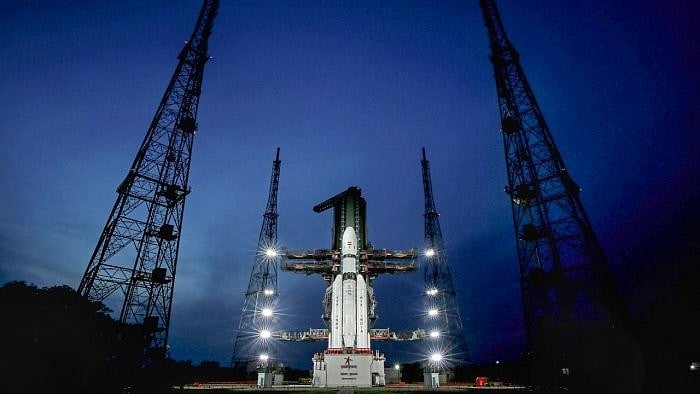
Chandrayaan-3 in Sriharikota.
Credit: PTI Photo
Indian Space Research Organisation's (ISRO) Chandrayaan-3 will attempt its descent to the moon's surface on August 23, 6:04 pm, and if successful India will become the fourth country to achieve this feat.
However, this will be no easy feat and the nation knows that all too well given the last mission—Chandrayaan-2—crashed.
To understand why the soft landing on the dark side of the Moon is difficult, it becomes essential to get more clarity about the proposed primary landing site.
Chandrayaan-3 proposed landing site
ISRO has planned a landing in the plateau located between the Manzinus and Boguslawsky craters, and a third Simpelious. The area is between 68 and 70° S and 31 and 33° E near the Moon's south pole.
An alternate landing site is also on the cards. This lies west to the Moretus crater, in an area between 68 and 70° S and 16 and 18° W.
The Moon's terrain
The south pole of the Moon is mountainous. The terrain is tough with the existence of major craters and extended lobate scarps that have remained in darkness for years, because of minimal sunlight.
The Geologic investigation of lobate scarps in the vicinity of Chandrayaan-3 landing site in the southern high latitudes of the moon study explains that there are two scarps near the proposed landing site of Chandrayaan-3.
What are scarps?
Apollo astronauts had left seismometers on the lunar surface to find that the there were tremors deep below the surface, likely due to the Earth's gravitational pull. There were also vibrations from meteorite impact.
However, these are shallow moonquakes which occur just a few miles beneath the surface of the celestial body. These convulsions could not be satisfactorily explained at the time, unlike other categories of quakes.
It would only be many years later that researchers arrived at the conclusion that these quakes were triggered across many young faults due to a combination of the Earth's gravitational pull and escaping internal heat.
These are thrust faults, where a geological block moves upwards against gravity when the area around it is squashed. Lobate scarps get formed when the lunar crust is pushed together as the Moon's surface contracts. The near-surface materials break, forming a thrust fault or lobate scarp.
Another study, Lobate Scarp in the Vicinity of Chandrayaan-3 Landing Site in the Southern High Latitudes of the Moon: Insights into Formation Age and Seismicity explains there is a "~58 km long segment of lobate scarp situated at an average horizontal distance of ~6 km in the west of the proposed primary landing site".
While the geological investigation of the lobate scarps near the Chandrayaan-3 proposed landing site notes that based on the researchers' analyses it appears that the landing site is safe from seismic hazards, the 58-km long stretch has been recently active seismically, which can cause shallow moonquakes, which, in turn, can lead to the ground shaking and the movement along lobate scarps can cause landslides and boulder-falls, potentially jeopardizing India's mission.
ISRO's plan for a safe landing
After Russia's recent failure with Luna-25, India is the only remaining nation in the race at the moment. Earlier in August, S Somanath, the ISRO chief, shared the plan the space agency has to ensure Chandrayaan-3's Vikram lander descends to the surface successfully.
At the 'Chandrayaan-3: Bharat's Pride Space Mission' talk, hosted by Disha Bharat, a non-profit organisation, the ISRO chief said there is a backup plan in place even if the sensors fail or engines malfunction.
"The entire design of the lander has been made in a manner that makes sure that it would be able to handle failures," he had detailed, adding, "If everything fails, if all the sensors fail, nothing works, still it (Vikram) will make a landing. That's how it has been designed - provided that the propulsion system works well."
However, it remains crucial that the Vikram lander transitions from a horizontal to a vertical position, which is where ISRO's last attempt had failed.
Somanath clarified that it was vital for the lander to be vertically aligned for a secure touchdown. A strategic sequence is in place, including a 'deboost' operation which will reduce the lander's velocity, after the lander propulsion module separates.